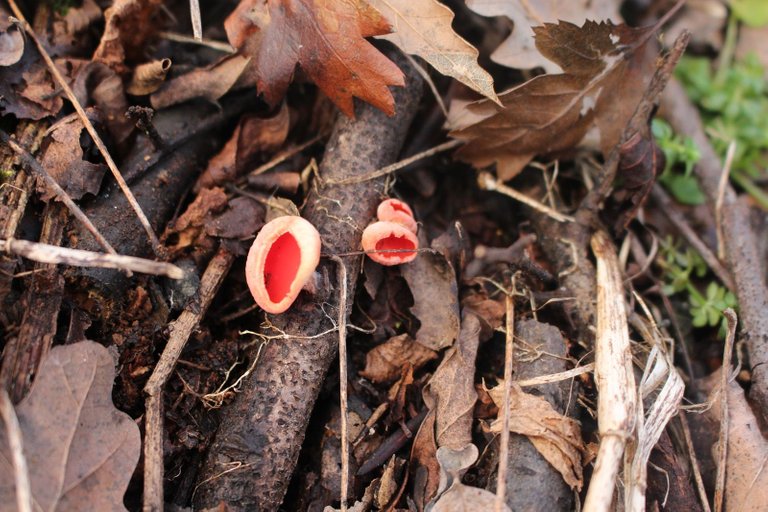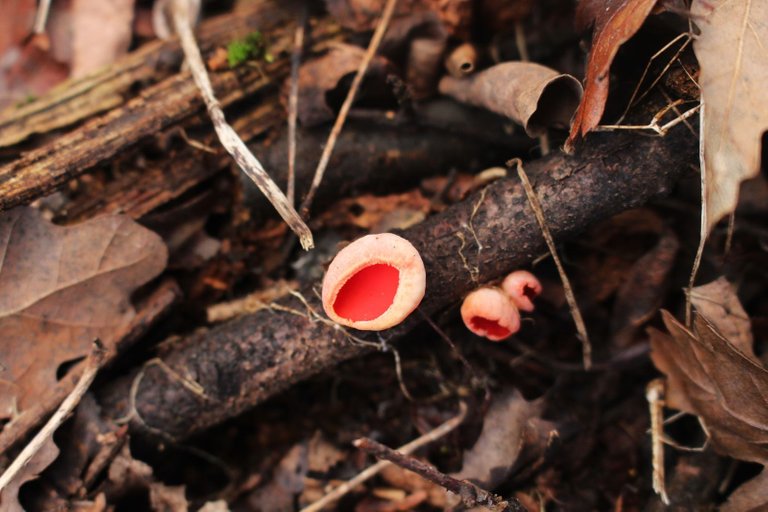Red goblet, Grandma's ear, scarlet cup...
Sarcoscypha coccinea is an adorable edible mushroom (not very tasty), strikingly red in color. Red goblet is one of the first fungi to appear after the snow melts. It grows on fallen, mostly acacia, branches that are partly buried in the ground. Its upper part is edible, the stem is not. This is not a mushroom that will amaze you with its taste, but it was used as a decoration, and it can even be candied. Scarlet cup is difficult to digest, so you should not eat much in quantity.
Folk names of plants and mushrooms are always interesting to me. It is clear why the plant is called the Red Cup, but why granny's ears? I did a little research and I hope I found the right answer.
Before, in our region, those who had delicate white skin and rosy cheeks were considered beautiful women. It was, so to speak, the ideal of beauty. That's why they rubbed this mushroom on their cheeks. It is actually a blush from nature, which girls would use for a wedding or some other festive event. Grandmothers often did this to children as well, because they looked healthier that way.
I also came across an interesting story. Before Easter, Christians in our country generally fast, and during that fast there are two weeks called "Ušna i Glušna" (roughly translated - ear and deaf week. It is very difficult to translate some words from Serbian to English.). In that period, it was forbidden to wash clothes, because the children would become deaf. Since two weeks is a long period of not washing clothes, which were then washed by hand mostly at the stream or by the river, the women made a special mixture of water and ash to which they added this mushroom.
They used to put laundry in that water to stand and the story goes that it was perfectly white. :) That way, the laundry was clean and the children were safe. Of course, this is an old folk belief that has been lost in these modern times. All that's left is the story.
I was delighted when I came across this mushroom, although they are small, they are easy to spot among the monotonous winter colors, especially those without snow. I don't pick mushrooms and rarely eat them, but I really enjoy their colors and shapes. This is definitely a real beauty and it's no wonder that she took a place in folk tales.
This is my contribution to #FungiFriday by @ewkaw. And of course - happy Fungi Friday :)
I hope you enjoyed my fungi story and this wonderful harbinger of spring. Spring is coming, and with it many other stories from nature. Until then...
With love,
Your Snežana





Congratulations @ladysnowhite! You have completed the following achievement on the Hive blockchain And have been rewarded with New badge(s)
Your next target is to reach 40000 upvotes.
You can view your badges on your board and compare yourself to others in the Ranking
If you no longer want to receive notifications, reply to this comment with the word
STOPCheck out our last posts:
Support the HiveBuzz project. Vote for our proposal!
I would never say that these fungi are edible! With that strong red color, I wouldn't go close to it at all...😂
Btw. That story about the name of it is great! Thanks for sharing!
I have picked this post on behalf of the @OurPick project which will be highlighted in the next post!
Well, that's how it is with mushrooms, they are full of surprises. :) Yes, I love those stories, especially about the origin of the name. Thanks for stopping by @ph1102
I really enjoyed reading about the old ways. The way people used to deal with things with whatever they had around and how they believed things help or harm.
This made me smile:
Happy #FungiFriday! :)
I'm glad you liked the story. I adore stories that connect folk beliefs and nature, especially the origin of words. Grandmothers are often mentioned here in toponyms and names of plants (grandmother's tooth, grandmother's hip, grandmother's stream...) and stories.
One of the reasons is probably that they practiced rituals and traditions and passed down customs from generation to generation. Thank you @ewkaw :)
What an amazing fungus! Interesting story about the tradition of days past. I like how those mushrooms are so brightly colored among the brush!
I never knew this mushroom was edible. Nice to read it’s story as well as watch pretty pictures 💙
Thank you @fantagira! ;) They are edible, but they don't have much taste and can't be eaten much. They are adorable in every way. Thanks for stopping by
And thank you for sharing 💙